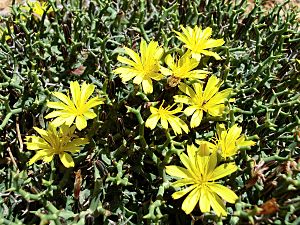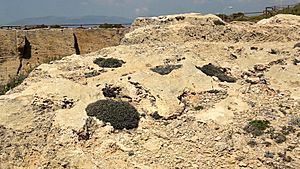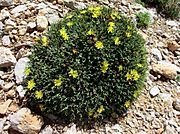Launaea cervicornis facts for kids
Quick facts for kids Launaea cervicornis |
|
|---|---|
 |
|
| Flowers | |
 |
|
| Habitat | |
| Scientific classification | |
| Genus: |
Launaea
|
| Species: |
cervicornis
|
| Synonyms | |
|
|
Launaea cervicornis is a special kind of flowering plant. It belongs to the Asteraceae family, which is also known as the daisy or sunflower family. This plant is only found in the Balearic Islands, a group of islands in the Mediterranean Sea near Spain. It grows mainly in areas along the coast where there are shrubs. This plant is very important for its environment, acting as a keystone species. This means it plays a big role in keeping its ecosystem healthy and balanced.
Contents
What is Launaea cervicornis?
Launaea cervicornis is a unique plant that has adapted to live in its specific coastal home. It is a type of plant that often grows low to the ground, forming a shrub-like shape. Its name, cervicornis, might come from the shape of its leaves or stems, which could look a bit like deer antlers.
Appearance and Features
This plant has flowers, just like other members of the daisy family. These flowers are usually small and might be yellow or white. They are designed to attract insects, which help the plant reproduce by carrying pollen from one flower to another. The leaves of Launaea cervicornis are also special. They are often tough and sometimes spiny, which helps the plant survive in dry, windy coastal areas.
How it looks
The plant's overall shape helps it deal with strong winds and salty air found near the sea. Its roots help to hold the soil in place, which is important in coastal areas where erosion can be a problem.
Where Launaea cervicornis Lives
Launaea cervicornis is native only to the Balearic Islands. These islands include Majorca, Minorca, Ibiza, and Formentera. It prefers to grow in coastal shrublands.
Coastal Shrublands Habitat
Coastal shrublands are areas near the sea where many shrubs and small plants grow. The soil in these places can be sandy and sometimes salty. Plants that live here need to be tough to handle the harsh conditions. This includes strong winds, bright sunshine, and not much fresh water. Launaea cervicornis has special ways to survive in this challenging environment.
Why it likes the coast
The plant thrives in these specific conditions. It has evolved over a long time to be perfectly suited for the climate and soil of the Balearic Islands' coastlines.
Why Launaea cervicornis is Important
This plant is known as a keystone species. A keystone species is like the central stone in an archway. If you remove that stone, the whole arch can fall apart. In nature, if you remove a keystone species, the entire ecosystem can change dramatically or even collapse.
Role in the Ecosystem
Launaea cervicornis helps its habitat in several ways. It provides food or shelter for local insects and small animals. Its roots help to stabilize the soil, preventing it from being washed away by rain or wind. This is very important in coastal areas where erosion can be a big problem.
Supporting other life
By keeping the soil stable and providing resources, Launaea cervicornis helps other plants and animals to survive in the same area. This makes it a crucial part of the Balearic Islands' coastal ecosystems.
Life Cycle and Reproduction
Like most flowering plants, Launaea cervicornis goes through a life cycle that includes flowering, producing seeds, and growing new plants.
How it Reproduces
The plant produces flowers that develop into seeds. These seeds are then spread, often by wind or animals, to new locations where they can sprout and grow into new plants. This process ensures the survival of the species.
Growing new plants
The ability to reproduce effectively is key for the plant to maintain its population in its native habitat.
See also
 In Spanish: Launaea cervicornis para niños
In Spanish: Launaea cervicornis para niños


